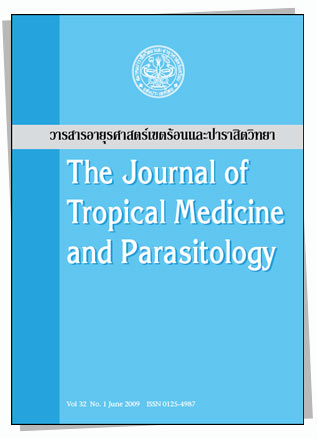Plasmodium gallinaceum: Specifically Recognized Antigens by Infected Sera
Main Article Content
บทคัดย่อ
Abstract
This study aimed to separate crude proteins of Plasmodium gallinaceum antigen (PgAg) by SDS-PAGE and detect reactive antigens with infected chicken sera by Western blot. Antigen was prepared from 80% parasitized chicken blood, differentially centrifuged to separate parasite cells from frozen lysed red blood cells. The parasite cells were sonicated and centrifuged. The soluble crude PgAg samples were separated and analyzed into protein bands with SDS-PAGE. Several proteins of blood-stage extract were in the molecular-weight (MW) range 22-205 kDa, with some protein bands at higher and lower MWs than the standard proteins. By Western-blot analysis, PgAg-blotted membranes reacted with sera from inoculated chickens with blood stage Pg; chickens in an endemic area diagnosed with malaria by symptoms and positive ELISA; chickens with malaria symptoms in a fresh-poultry market, and other diseases; a blood protozoan (Leucocytozoon sabrazesi) co-infected with other parasites; a coccidian (Eimeria tenella); and Newcastle virus, including negative serum. The results showed 2 malarial protein bands, ie, 32.5 kDa reacted with all Pg-inoculated sera, and some positive sera by ELISA and endemic area. Another antigen was MW 72 kDa, with all Pg-inoculated sera and endemic sera, but not with ELISA-positive sera. This study showed that malaria-infected chickens produced specific antibodies against two interesting avian malaria antigens, of MW 32.5 and 72 kDa, which can be used in Western blot detection.
Keywords : Plasmodium gallinaceum antigen, chicken sera, SDS-PAGE, immunoblot

